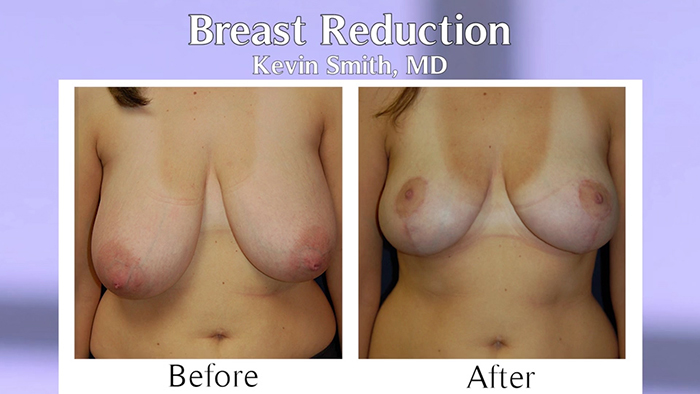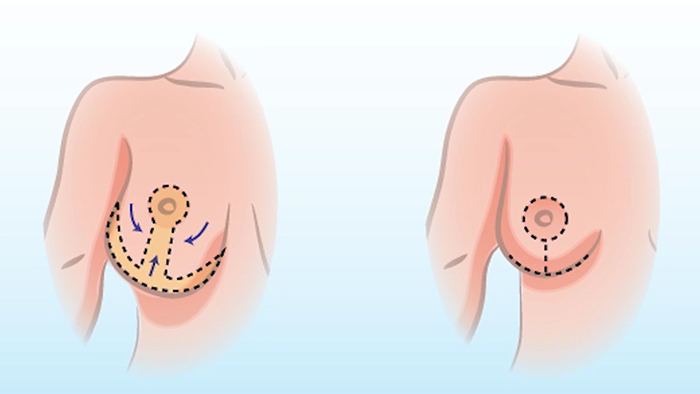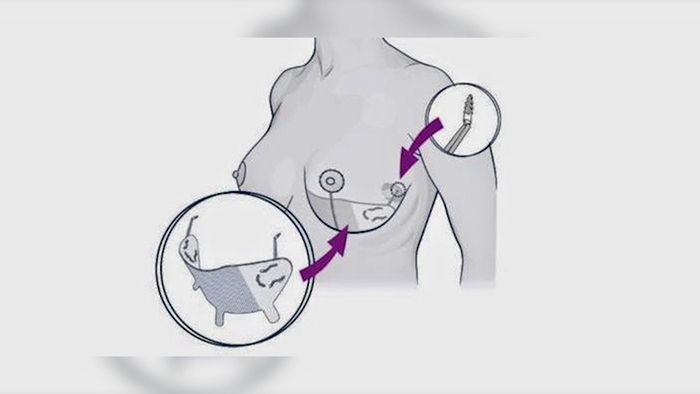While large breasts are usually inherited, hormones, pregnancy, menopause and weight gain can all contribute to an increase in breast size. The latest statistics from the American Society of Aesthetic Plastic Surgeons report over 103,000 women opted for breast reduction surgery last year making it the 8th most popular aesthetic surgery.
Those who live with large, heavy breasts might describe breast reduction as more of a physical relief than a cosmetic procedure. Dr. Kevin Smith of Charlotte believes breast reduction patients to be some of his happiest. “They experience such a boost in confidence,” he explains. “I can relieve their physical discomfort and create an aesthetically pleasing result that will allow them to participate in activities that were formerly restricted or difficult due to large breasts. It’s a wonderful operation.”
The Psycho-social Effects of Large Breast
The physical discomfort experienced by women with large breasts are just part of the story. In many cases it is nearly impossible for a woman to be active in any sports where agility, balance or impact is part of the game. Another challenge is finding clothing that truly fits and flatters, so outfits are usually chosen to conceal size. According to Smith, the stigma of being large and having to cover up is particularly embarrassing for younger girls in their teens. “It’s certainly hard enough to be a teenager much less being one with large breasts,” he says. “I will offer the operation to girls as young as late teens. After surgery they are so empowered and feel a confidence they never experienced before.”
There are professional consequences as well. Dr. Smith cites a young marine who had been through boot camp and was obviously fit, but struggled with large, heavy breasts. “After her breast reduction she went from a 65 to a 95 percentile in physical fitness testing.”
Waiting for Post-Baby?
Some women know they will someday seek a breast reduction, but want to have a family first so as not to interfere with breastfeeding. This might not be a wise choice according to Dr. Smith. “Of course, this is a very personal decision and we cannot guarantee 100% that you can breast feed post-surgery. But statistics show that near 90% breast feed just fine. With newer techniques we are able to save duct work and sensibility to the nipple that allows breast feeding.”
Breast Reduction: Fit to Frame
The added bonus to having a breast reduction is that the breast shape is not only reduced but also lifted to a more youthful position. The breasts are not just reduced, they are enhanced. “It’s very important that the reduction performed fits the patient’s body size and frame,” says Smith. “Every candidate wants to be smaller, but we want to leave a pretty breast behind and that necessitates a certain amount of volume to fill the breast ‘cone’ – usually it is the equivalent of an average C cup.” Proportion is key and a board certified plastic surgeon will know the right amount of reduction required to deliver the perfect fit.
Will Insurance Pay for a Breast Reduction?
As powerful a change agent as aesthetic surgery can be for self-image and confidence, it is considered elective and therefore an out of pocket expense. However, in more cases than you might expect, breast reduction surgery is covered by insurance when considered to be, “functional.” Dr. Smith’s office is finding that many insurance companies now ask for 6 months of documentation to prove other medical care and therapy attempts have failed prior to approving a breast reduction. Height and weight factors have recently become part of the evaluation that drives the decision for coverage.
How it’s done
Breast reductions are done under general anesthetic on an outpatient basis. Most require an incision around the nipple areola, down the front of the breast and into the fold. The central portion of the breast tissue is saved and all the ducts and nerves stay intact. Once the breast is reduced to smaller size the nipple is repositioned for a perkier profile. There are visible scars, but they fade with time.
Dr. Smith emphasizes that post-op recovery is relatively easy when compared with other surgeries that involve muscles, like a tummy tuck. He also uses Exparel® – a regional nerve block that acts as a non-narcotic, long-lasting anesthetic. “This gives our patients relative numbness and comfort for up to 3 days after surgery.”
The best news? After surgery there is immediate relief from the symptoms of large, heavy breasts.
An Internal Bra
Heavy breasts in particular exhibit stretched out skin that doesn’t hold up very well. “We do our best to reposition, reattach and tighten up the skin envelope but we are often still faced with stretchy skin,” explains Smith. “Now there are biocompatible meshes we can use, which essentially involves tailoring a demi bra that we put on the inside of the breast.”
One mesh Dr. Smith likes is GalaFLEX. This absorbable mesh lasts 18 months and is eventually replaced by the body’s own tissue. “It anchors the inframammary fold and those breasts stay in position. There is less chance of revision surgery necessitated by having to tighten up the position of breasts that have settled too low. They stay where you put them.”
A Word of Advice
We have seen the full-breasted figures of decades ago fade away, giving way to the smaller, slimmer, more athletic bodies of the health and exercise conscious women of today. Dr. Smith tells women with chronic neck, back, and shoulder pain and infections, “Don’t wait. All your symptoms can be resolved after surgery and you can feel better and lose the self-consciousness. To dress normally, wear a swimsuit, and participate in sports – it’s a new beginning. The only regret I ever hear is, ‘Why didn’t I do this earlier?’”

















Facebook
Twitter
Instagram
YouTube
RSS